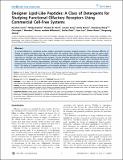Designer Lipid-Like Peptides: A Class of Detergents for Studying Functional Olfactory Receptors Using Commercial Cell-Free Systems
Author(s)
Baaske, Philipp; Wienken, Christoph J.; Jerabek-Willemsen, Moran; Duhr, Stefan; Luo, Yuan; Braun, Dieter; Corin, Karolina A.; Ravel, Deepali B.; Song, Junyao; Brown, Emily E.; Wang, Xiaoqiang; Zhang, Shuguang; ... Show more Show less
DownloadCorin-2011-Designer lipid-like.pdf (707.5Kb)
PUBLISHER_CC
Publisher with Creative Commons License
Creative Commons Attribution
Terms of use
Metadata
Show full item recordAbstract
A crucial bottleneck in membrane protein studies, particularly G-protein coupled receptors, is the notorious difficulty of finding an optimal detergent that can solubilize them and maintain their stability and function. Here we report rapid production of 12 unique mammalian olfactory receptors using short designer lipid-like peptides as detergents. The peptides were able to solubilize and stabilize each receptor. Circular dichroism showed that the purified olfactory receptors had alpha-helical secondary structures. Microscale thermophoresis suggested that the receptors were functional and bound their odorants. Blot intensity measurements indicated that milligram quantities of each olfactory receptor could be produced with at least one peptide detergent. The peptide detergents' capability was comparable to that of the detergent Brij-35. The ability of 10 peptide detergents to functionally solubilize 12 olfactory receptors demonstrates their usefulness as a new class of detergents for olfactory receptors, and possibly other G-protein coupled receptors and membrane proteins.
Date issued
2011-11Department
Massachusetts Institute of Technology. Center for Biomedical Engineering; Massachusetts Institute of Technology. Department of Biological Engineering; Massachusetts Institute of Technology. Department of BiologyJournal
PLoS ONE
Publisher
Public Library of Science
Citation
Corin, Karolina et al. “Designer Lipid-Like Peptides: A Class of Detergents for Studying Functional Olfactory Receptors Using Commercial Cell-Free Systems.” Ed. Fabrizio Gelain. PLoS ONE 6.11 (2011): e25067. Web. 8 Feb. 2012.
Version: Final published version
ISSN
1932-6203